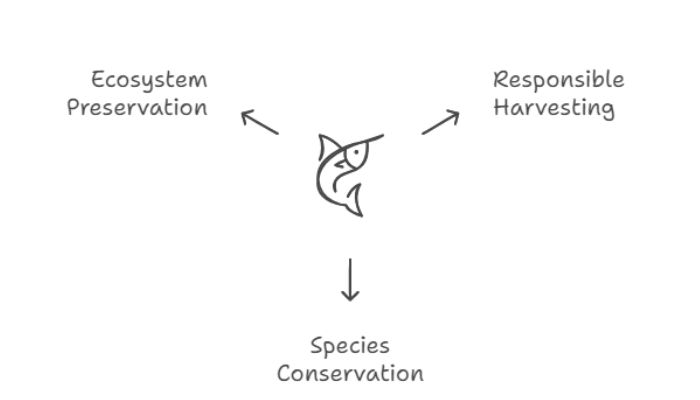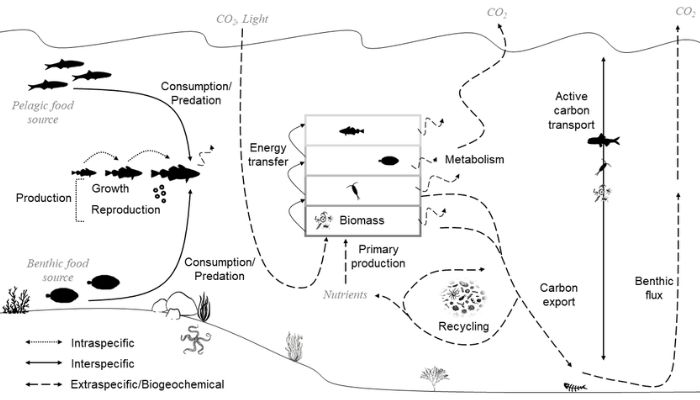Sustainable fish refers to seafood harvested or farmed in ways that maintain healthy populations, minimize environmental impact, and support local fishing communities.
In terms of sustainability, wild-caught fish can be sustainable if harvested using methods that limit bycatch (unintentional catch of other species) and avoid damaging marine habitats. On the other hand, farmed fish (aquaculture) can also be sustainable if managed responsibly, such as by using eco-friendly feed, minimizing water pollution, and ensuring proper fish health and welfare.
Key aspects of sustainable fishing include:

- Responsible Harvesting: Adopting fishing methods that reduce overfishing and bycatch while protecting sensitive habitats.
- Species Conservation: Focusing on the health of fish populations, avoiding overexploited or endangered species.
- Ecosystem Preservation: Maintaining marine biodiversity and promoting a balanced ecosystem by minimizing habitat disruption.
Why Is Sustainable Fishing Important?
Sustainable fishing is crucial for maintaining the health of marine ecosystems, preserving biodiversity, and supporting the livelihoods of communities that depend on the ocean’s resources.
Preventing Overfishing
Overfishing occurs when fish are caught faster than they can reproduce, leading to declining populations and disrupting the food chain. This not only threatens the survival of specific fish species but also affects the broader marine ecosystem, as predators lose their prey, and algae populations can grow unchecked, impacting water quality.
Protecting Marine Ecosystems

Certain fishing methods, like bottom trawling, can cause extensive damage to marine habitats, such as coral reefs and seafloor ecosystems, leading to a loss in biodiversity. Sustainable fishing emphasizes the use of selective and eco-friendly methods, like line fishing and traps, to minimize habitat destruction and reduce bycatch of non-target species.
Supporting Fishing Communities
Sustainable fishing not only benefits the environment but also supports the economic and social well-being of local fishing communities. By managing fish stocks responsibly, it ensures a consistent supply of seafood, creating long-term job opportunities and sustaining the livelihoods of those who rely on fishing.
How to Identify Sustainable Fish
Choosing sustainable fish can be challenging, but understanding certifications, seafood guides, and sourcing practices makes it easier.
Certifications and Labels
Look for recognized certifications that ensure seafood meets strict environmental and social standards. Some common certifications include:
- Marine Stewardship Council (MSC): The MSC label indicates that wild-caught seafood comes from well-managed fisheries that use sustainable practices to protect fish populations and marine habitats.
- Aquaculture Stewardship Council (ASC): This label is for responsibly farmed seafood, ensuring that aquaculture operations minimize environmental impact, use eco-friendly feed, and maintain high standards of fish welfare.
- Fair Trade Certified: This certification focuses on social and environmental standards, ensuring that seafood is harvested in ways that protect workers’ rights and promote responsible environmental practices.
These labels provide consumers with assurance that the seafood they purchase is sourced in a way that supports long-term ocean health and ethical fishing communities.
Understanding Seafood Guides
Seafood guides, such as the Seafood Watch program by the Monterey Bay Aquarium, are valuable tools for making informed choices. These guides evaluate seafood species based on factors like population health, fishing methods, and habitat impact. They categorize seafood into lists such as:
- Best Choice: Indicates the most sustainable options.
- Good Alternative: Acceptable options, but with some environmental concerns.
- Avoid: Seafood that poses a high risk to the environment due to overfishing or harmful farming practices.
Using these guides helps consumers select seafood that aligns with sustainability goals.
Questions to Ask When Buying Seafood
When buying seafood, whether from a fishmonger or a restaurant, ask the following key questions:
- “Where is this fish sourced from?”
- “Is it farmed or wild-caught?”
- “Is it certified by an organization like MSC or ASC?”
- “Is this fish in season?”
Asking these questions helps ensure that you choose seafood sourced in a responsible and sustainable manner.
Choosing Seasonal and Locally Sourced Fish
Seasonal fish are often more abundant, leading to lower fishing pressure on stocks. Local sourcing supports regional fisheries and minimizes the carbon footprint associated with shipping seafood long distances.
